Greek shrimp saganaki is made with tender shrimp, homemade tomato sauce, creamy feta cheese and fresh parsley. It’s so good you’ll wonder why you haven’t tried shrimp saganaki before! This simple one-pan meal idea is a great protein-rich option for a comforting, easy appetizer or side dish. Or serve with rice, pasta or grilled vegetables for a more filling dinner idea!
This shrimp saganaki recipe has some secret ingredients to take it to the next level. I love dipping fresh bread into the excess tomato sauce and creamy feta for a delicious bite every time.
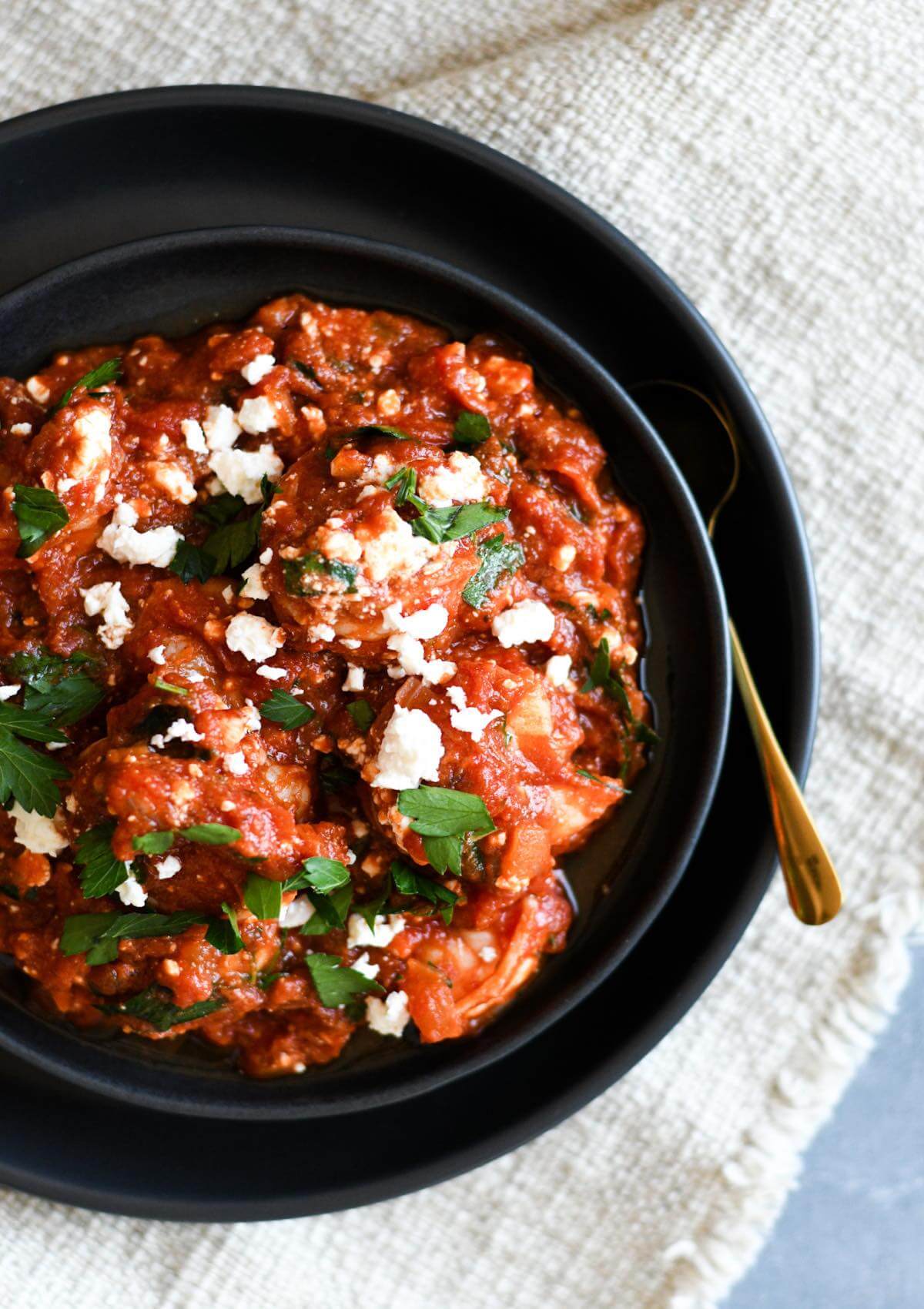
WHAT IS SAGANAKI?
Saganaki is a variety of appetizers that are cooked in a small, heavy frying pan. The most popular saganaki recipe you’ve probably seen on Greek restaurant menus is cheese saganaki. Cheese saganaki can be made with halloumi, graviera, kefalotyri, or feta cheese.
WHAT IS THE DIFFERENCE BETWEEN PRAWNS AND SHRIMP?
Both prawns and shrimp can be purchased fresh or frozen, raw, cooked, peeled and deveined, or shell-on. Technically, prawns and shrimp are two distinct animals with genetic and behavioural differences. Luckily for us, shrimp and prawns are almost identical in taste and texture, so they can be used interchangeably in recipes.
Shrimp and prawns come in various sizes, from very small shrimp, where a dozen can fit in a tablespoon, to jumbo tiger prawns. You can find fresh shrimp at the grocery store in the seafood section. It’s also sold in bags in the frozen section.
The numbers on the outside of the bag are how many prawns there are per pound. For example, bags that say 16-21 shrimp per pound are larger shrimp compared to 31-40 shrimp per pound. Some jumbo prawns would be about 6-8 per pound. I usually portion about 4-5 shrimp per person when serving Greek shrimp saganaki as an appetizer. You can also serve shrimp saganaki with Greek rice, pasta or grilled veggies like broccolini for a more filling dinner idea.
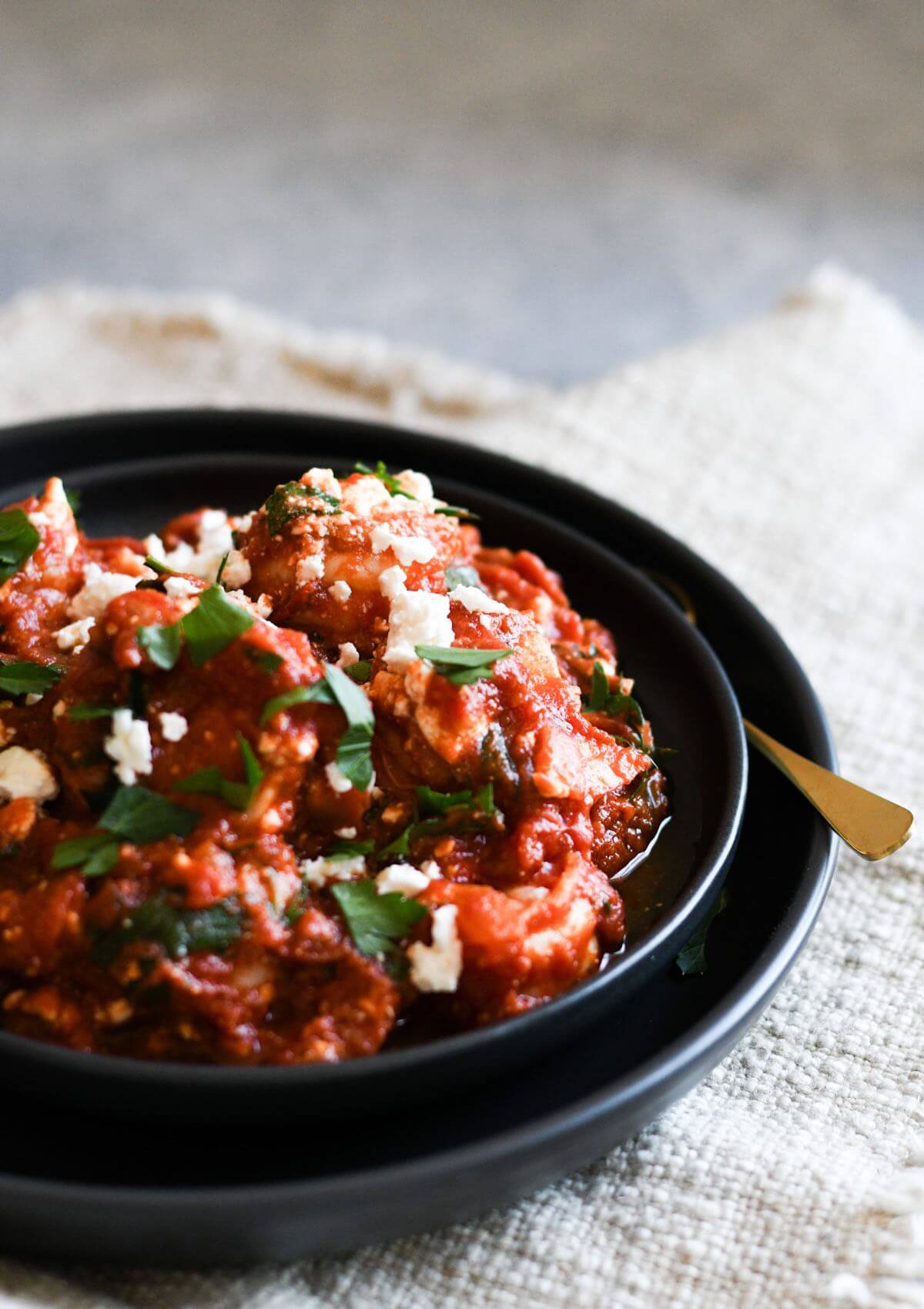
RECIPE TIPS
- For best results, use fresh, medium or large-size shrimp or prawns. If you’re using frozen shrimp, run the frozen shrimp under cold water to dethaw or place the frozen shrimp in your fridge to dethaw overnight. Rinse the shrimp really well with cold water before adding them to the pan with tomato sauce.
- You can keep the tails on or remove them, but the shrimp should be peeled and deveined.
- The prawns should only need a few minutes to cook. If they’re overcooked, they may turn rubbery. The time it takes for prawns to cook will depend on the size. Small to medium-sized prawns will cook in about 3-4 minutes, large prawns about 5-6 minutes and jumbo prawns about 7-9 minutes.
- You could also top the saganaki with feta cheese and then place it in the oven for a few minutes for the feta cheese to get golden brown. If you’re going to try this method, make sure the prawns are cooked for less time in the tomato sauce (since they will continue to cook in the oven and afterwards) and that you’re using an oven-safe skillet or dish.
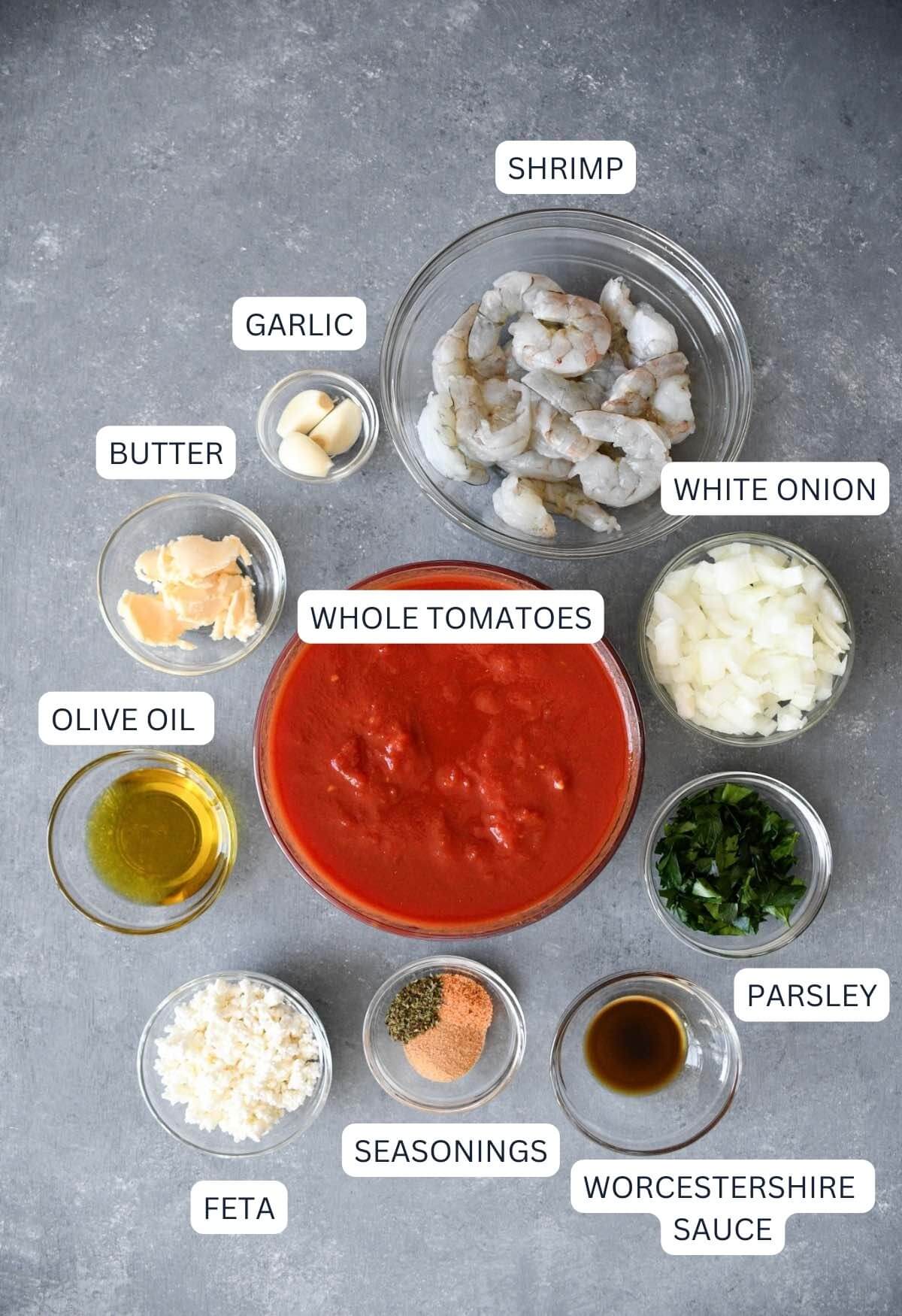
INGREDIENT NOTES
Prawns or shrimp: The prawns should be medium or large to stay plump and juicy as they cook. If the prawns are too small, they will cook too quickly and become rubbery. I’d recommend 1 pound of medium or large shrimp when making this dish as an appetizer for four people.
I’d recommend either 16-20 shrimp per pound or 31-40 shrimp per pound. This recipe makes about four servings, depending on how many shrimp you’d like to have per person. Shrimp are protein-rich, cook quickly and are neutral in flavour, so they absorb all of the delicious tomato sauce flavours.
Tomatoes: I recommend using a can of Italian peeled plum whole tomatoes because it saves time instead of peeling and dicing tomatoes. Plus, then you can make shrimp saganaki any time of the year. Crush the whole tomatoes in a separate bowl using your hands or a fork before adding them to the frying pan with garlic and onions.
But, if tomatoes are in season, you could use ripe, juicy tomatoes like Roma tomatoes instead of canned tomatoes. Or use a combination of canned peeled plum tomatoes and fresh tomatoes. If you’re using fresh tomatoes, I’d recommend peeling and dicing them before making the tomato sauce.
Onions: I love using white or yellow onions because they become slightly sweet when cooked. But, you could use red onion instead if that’s what you have on hand or prefer.
Fresh parsley: Fresh herbs mixed in at the end add brightness and freshness. You can also use fresh dill or basil.
Wine: A dry white wine like pinot grigio, sauvignon blanc or chardonnay works great. A sweet wine like Riesling would also be delicious to add some sweetness to counteract the acidity in tomato sauce and balance out the saltiness of feta cheese. You could also use ouzo instead of white wine, which is more traditional for shrimp saganaki.
The Secret Ingredients: Are you ready for the secret ingredients!? They are… Worcestershire sauce (I can never pronounce this) and anchovy paste add a depth of flavour to the tomato sauce. If you have these at home, you should try them, but there’s no need to go out and buy these ingredients if you don’t want to. Anchovy paste and Worcestershire sauce have a long shelf life and can be used in various dishes like pasta sauces and salads, so they are versatile ingredients to have on hand.
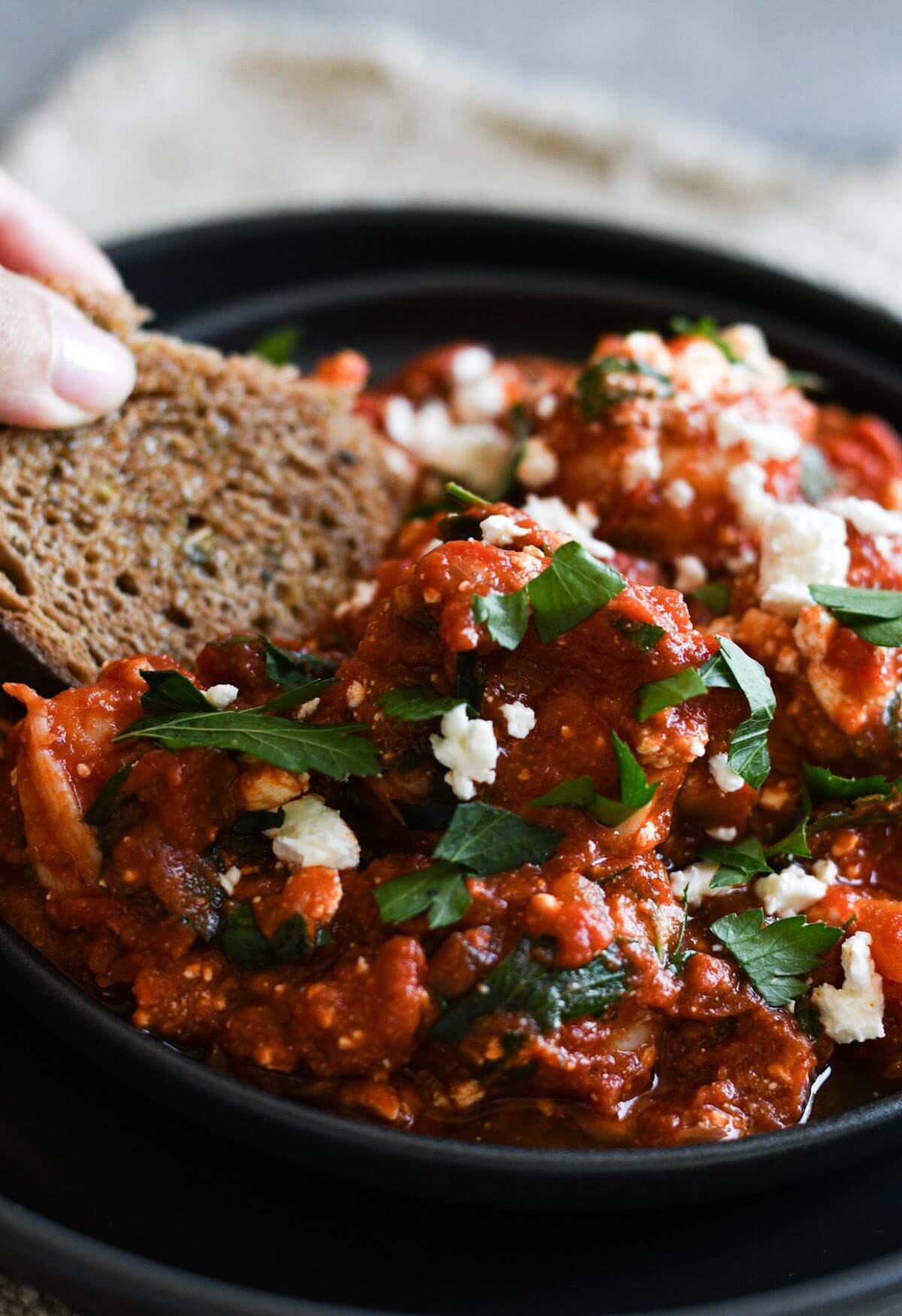
HOW TO MAKE SHRIMP SAGANAKI: STEP BY STEP
STEP 1: Thaw and rinse the prawns. Rinse the thawed prawns really well with cold water using a colander or strainer. Cover the prawns with saran wrap and set aside in the fridge until you’re ready to add them to the sauce.
STEP 2: Cook the tomato sauce: Heat up the olive oil and butter in a large skillet. Sauté the chopped onion for a few minutes on medium-low heat until translucent, and then add in the diced garlic and chilli flakes. Cook for a couple of minutes together, and then pour in the white wine and cook over medium heat for a few minutes until most of the liquid evaporates.
In a separate large bowl, pour in the can of tomatoes. Add a couple of teaspoons of sugar to cut the acidity of the tomatoes, and use your hands or a fork to crush the tomatoes together. Pour the tomatoes into the pan and cook together with the onions and garlic. Add the Worcestershire sauce, seasoning salt, garlic powder, dried oregano, anchovy paste, and water. Simmer over medium heat, uncovered, for 25-30 minutes. Stir occasionally. The longer the sauce cooks, the sweeter it will be. The sauce will reduce and thicken as it cooks.
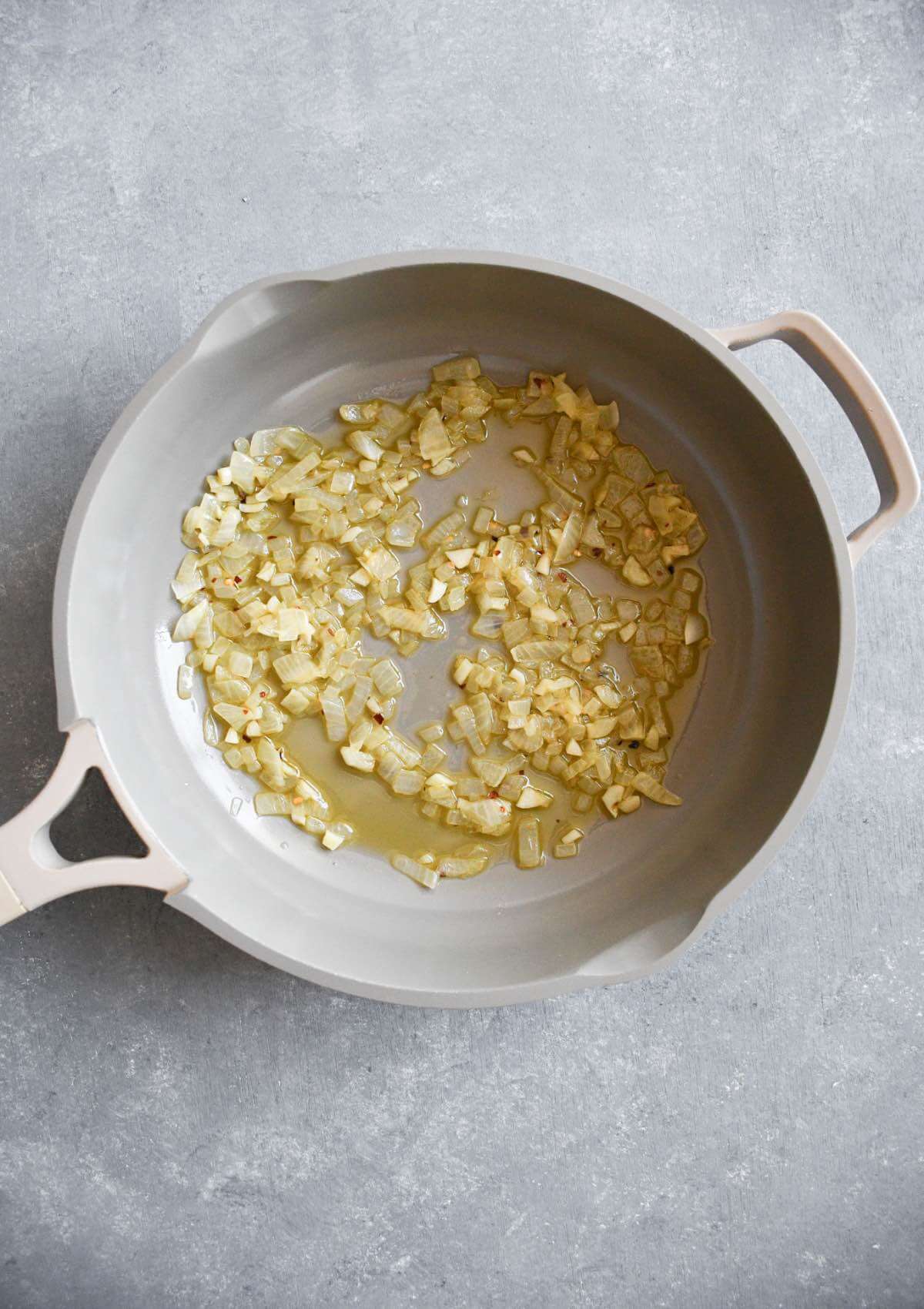
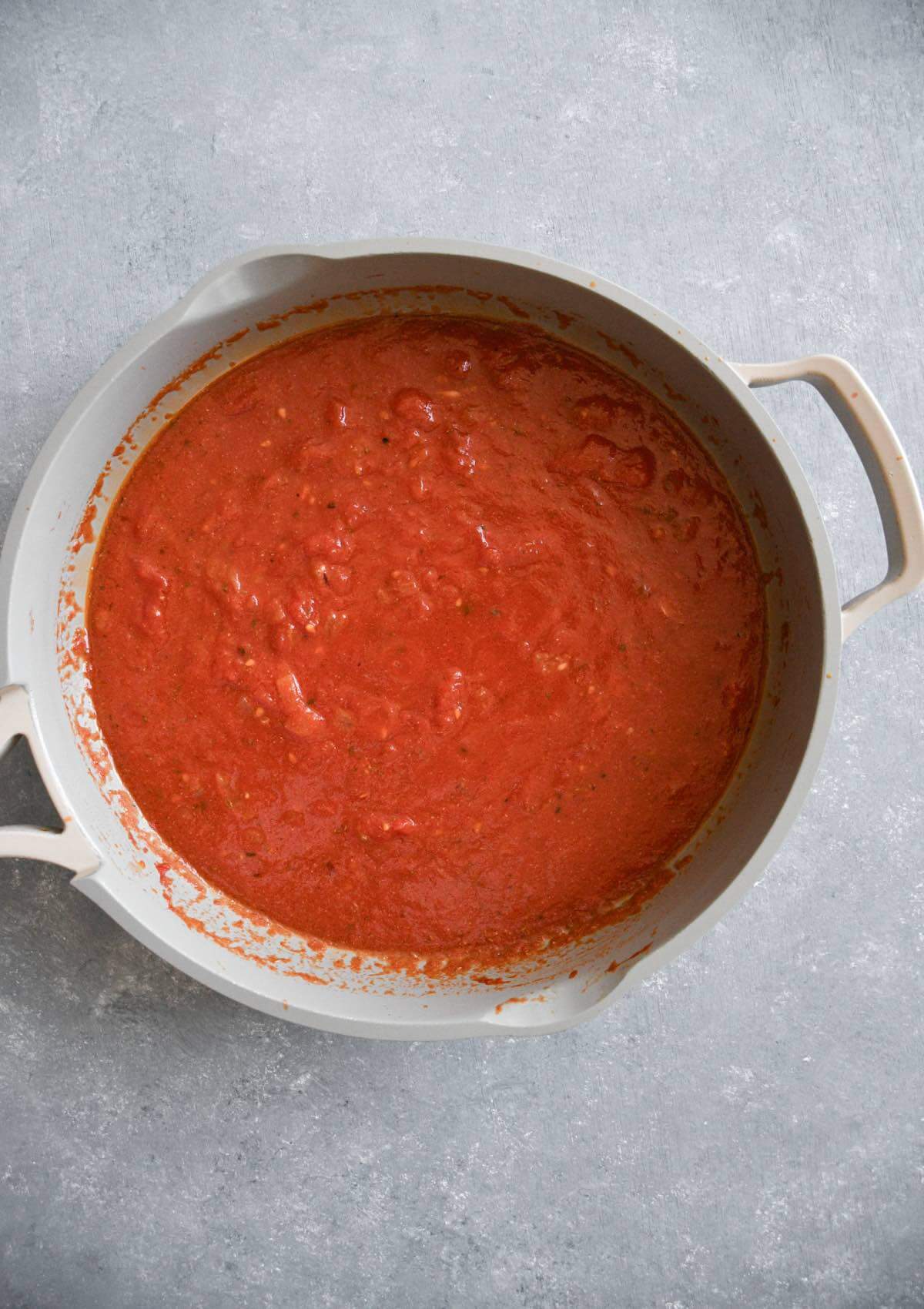
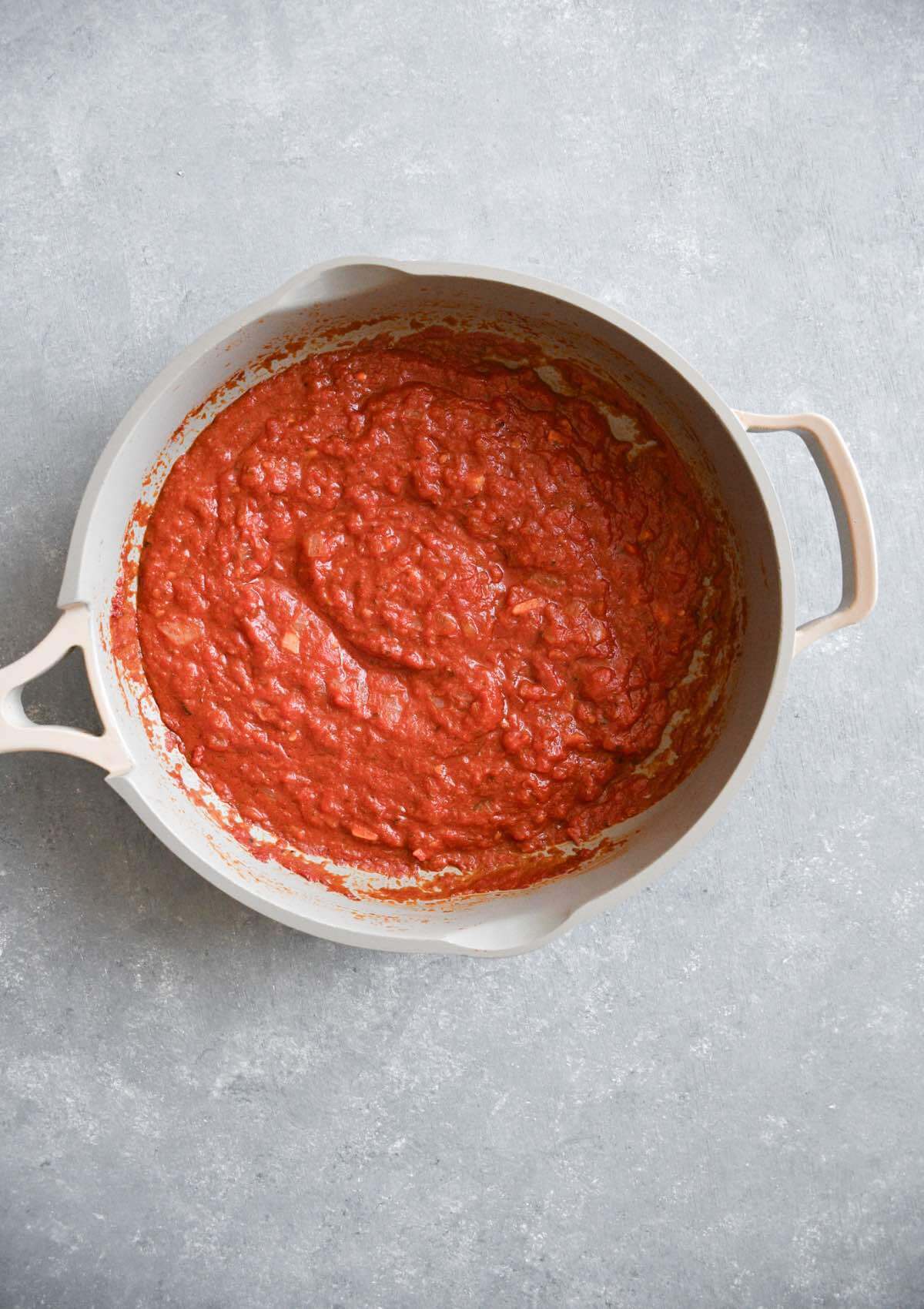
STEP 3: Add the shrimp to the sauce: Arrange the shrimp in a single layer in the tomato sauce and continue to cook over gentle heat. Cook the shrimp for 5-6 minutes, turning halfway through until the shrimp are opaque pink. If the shrimp are larger, they need an extra minute or two to cook.
STEP 4: Add Feta and garnish: Turn off the heat and remove the pan from the element once the shrimp are cooked. Sprinkle with crumbled feta cheese and finely chopped parsley. Stir to mix everything together, and enjoy with plenty of crusty bread, pita bread or rice. Adjust the salt and pepper to taste. Serve straight away and enjoy!
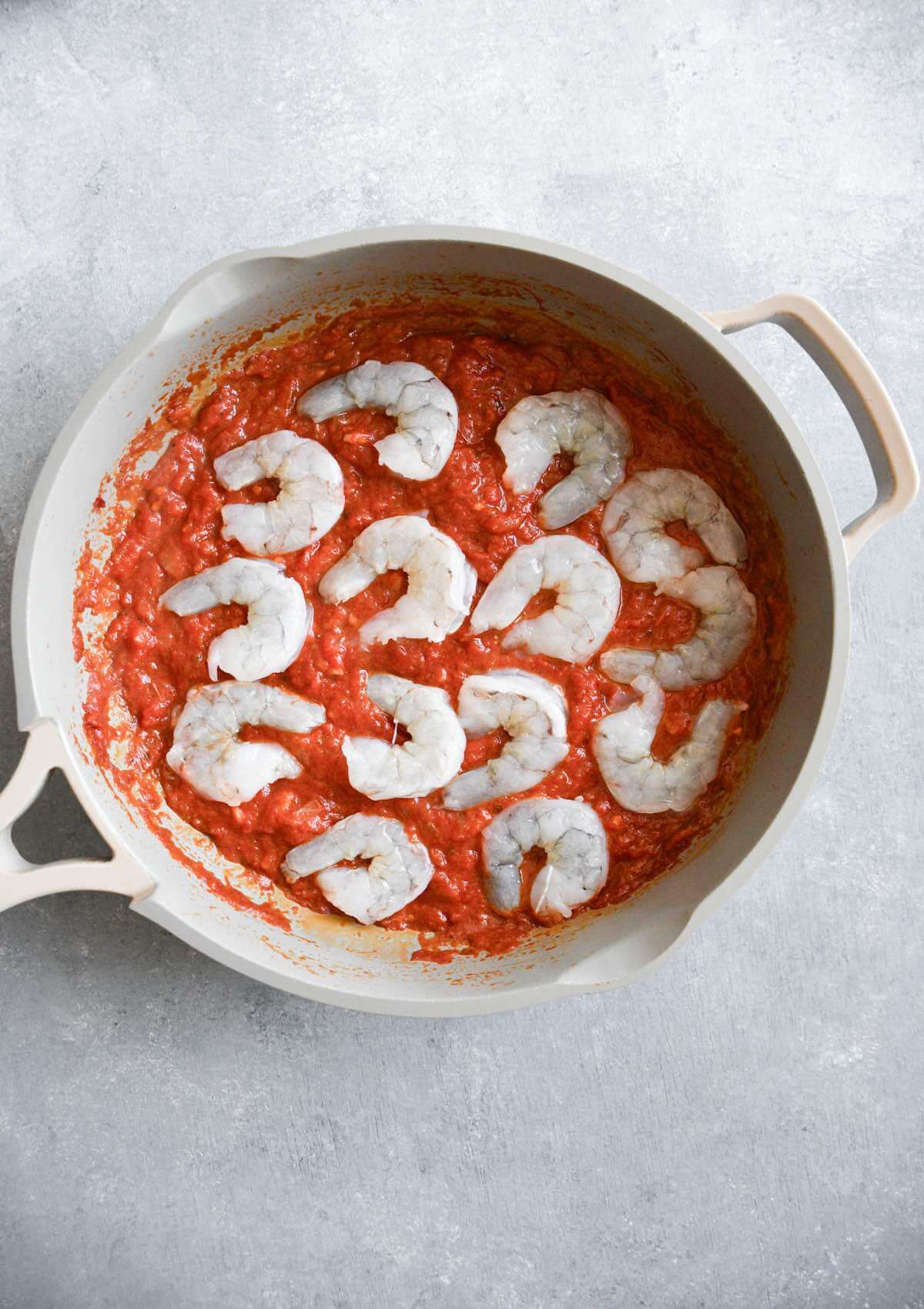
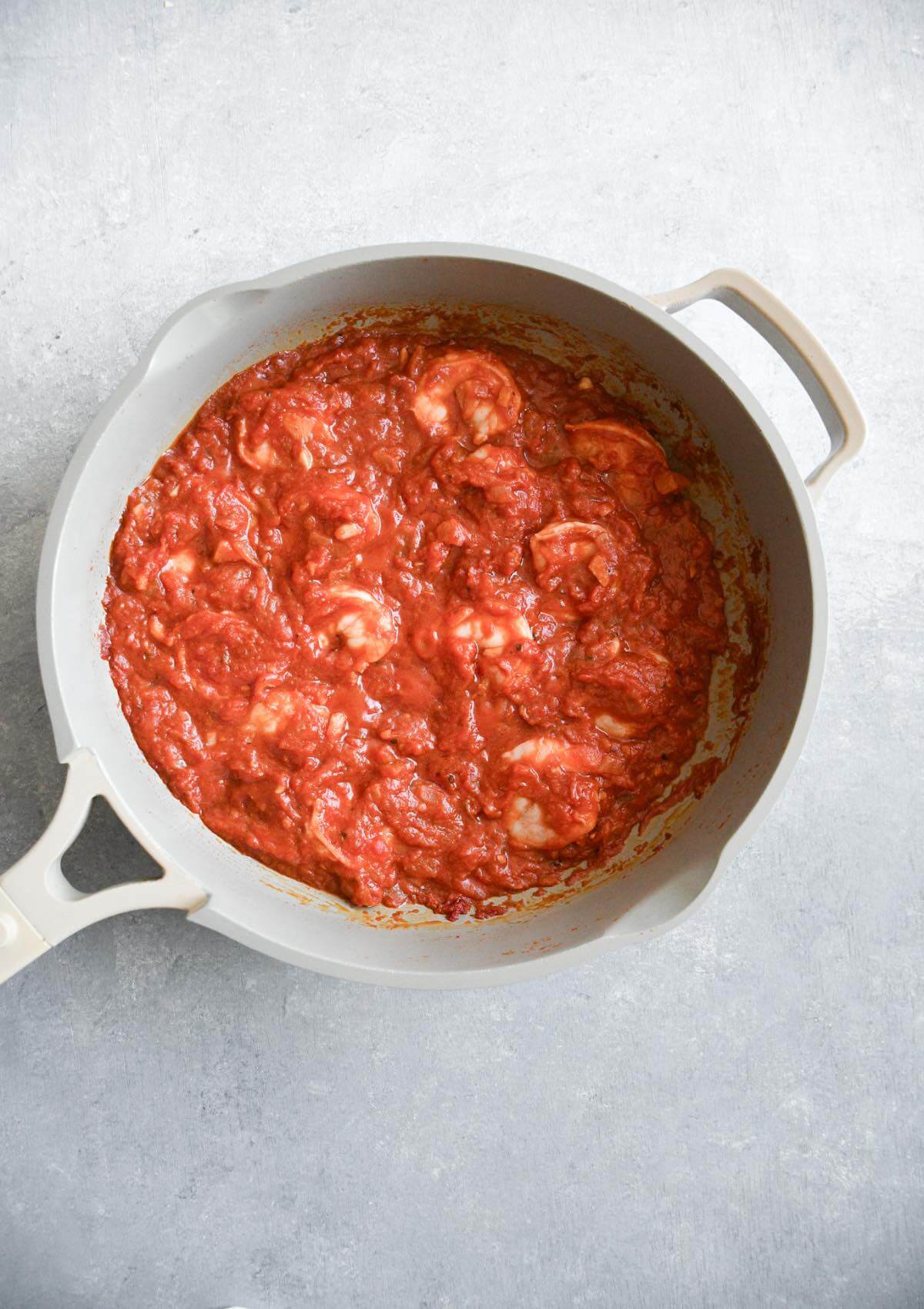
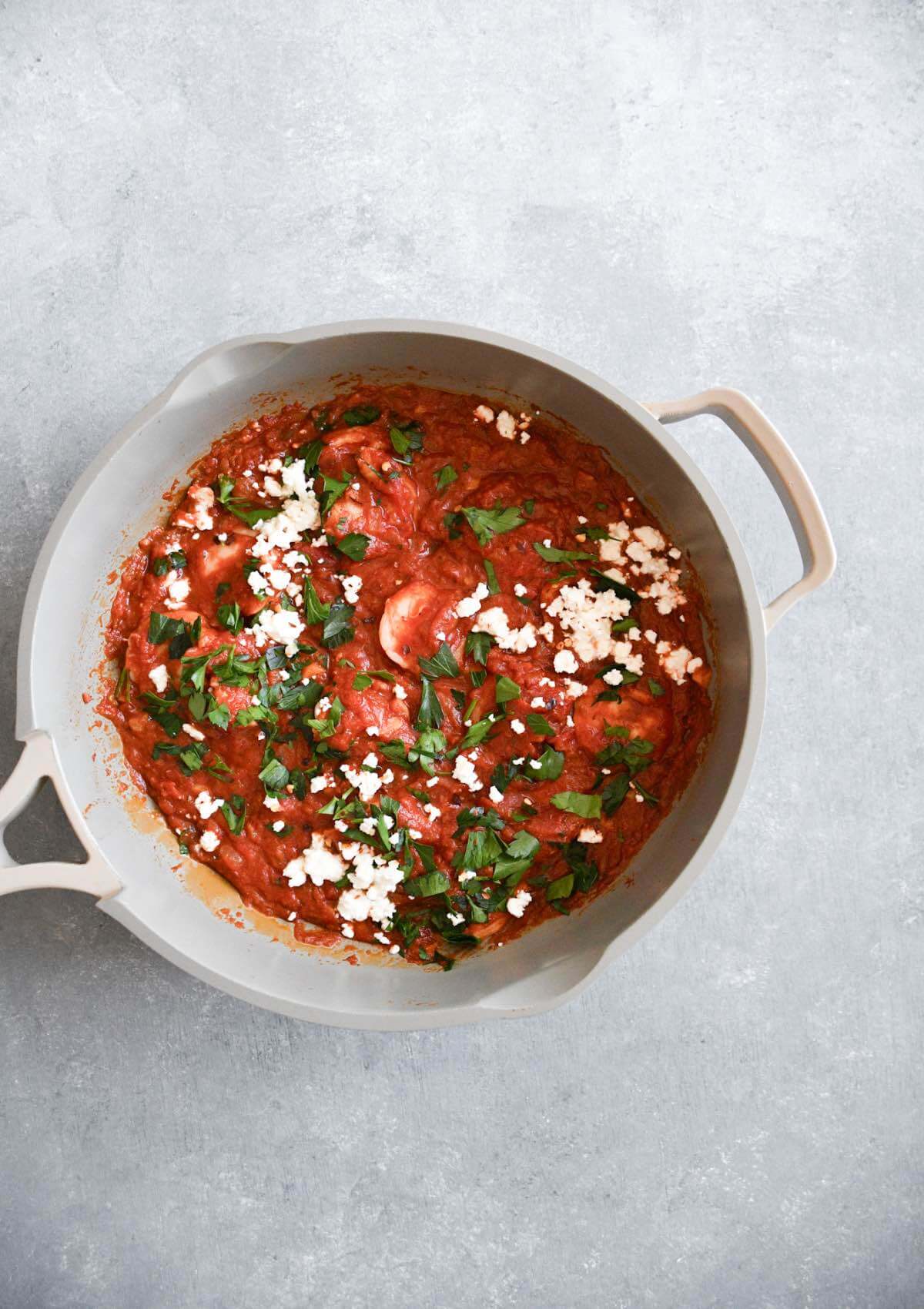
STORING AND SERVING
Shrimp saganaki can last for up to 3 days in the fridge. After cooking, allow the saganaki to come to room temperature. Then, transfer it to an airtight container and store it in the fridge.
Greek shrimp saganaki tastes best when made fresh, but if you’d like to prepare this recipe beforehand, it’s easy to do! If that’s the case, I recommend making the tomato sauce first, allowing it to cool, and storing it in an airtight container in the fridge. The sauce will last for up to three days in the fridge.
When ready to serve this dish, heat the tomato sauce in the frying pan, then add the fresh marinated shrimp. Cook for a few minutes or until the shrimp are cooked. Sprinkle in the feta cheese and fresh parsley.
- Homemade Spicy Spaghetti Sauce Recipe
- Fasolakia With Tomato Sauce (Greek Green Beans)
- The Best Creamy Tomato Pasta Sauce
Greek Shrimp Saganaki Recipe
Equipment
- 1 colander
- 1 large frying pan
Ingredients
- 1 pound fresh or frozen shrimp (peeled and deveined) medium or large shrimp (about 31-40 or 16-20 per bag)
- 3 tablespoons olive oil to sauté the onions and garlic
- 2 tablespoons butter
- 3 cloves garlic finely diced
- 1/2 cup white onion peeled and diced
- 1/4 teaspoon red chili flakes optional
- 1/4 cup white wine
- 1 large can Italian whole peeled plum tomatoes San Marzano or Italissima (796 ml or 28 oz.)
- 2 teaspoons sugar
- 1/4 teaspoon Worcestershire sauce
- 1/4 teaspoon anchovy paste
- 1 ½ teaspoons garlic powder
- 1/4 cup warm water
- 1 teaspoon dried oregano
- 1/4 cup crumbled feta cheese
- 1/4 cup finely diced parsley Fresh flat leaf Italian parsley
- 1/4 teaspoon salt
- 1/4 teaspoon pepper
Instructions
- Thaw and rinse the shrimp: Rinse the thawed shrimp really well with cold water using a colander or strainer. Cover the rinsed shrimp with saran wrap and set aside in the fridge until you can add them to the sauce.1 pound fresh or frozen shrimp (peeled and deveined)
- Cook the tomato sauce: Heat up olive oil and butter in a large frying pan. Sauté the diced onion for a few minutes on medium heat until translucent, and then add in the diced garlic and chili flakes. Sauté for a few minutes and then pour in the white wine and cook over medium heat for a few minutes until reduced. In a separate large bowl, pour in the can of tomatoes. Add the sugar and use your hands or a fork to crush the tomatoes together. Pour the tomatoes into the pan and cook together with the onions and garlic. Add the worcestershire sauce, salt, pepper, dried oregano, garlic powder, anchovy paste, and water. Simmer over medium-low heat, uncovered, for 25-30 minutes. The longer the sauce cooks, the sweeter and thicker it will become.3 tablespoons olive oil, 2 tablespoons butter, 3 cloves garlic, 1/2 cup white onion, 1/4 teaspoon red chili flakes, 1/4 cup white wine, 1 large can Italian whole peeled plum tomatoes, 2 teaspoons sugar, 1/4 teaspoon Worcestershire sauce, 1/4 teaspoon anchovy paste, 1 ½ teaspoons garlic powder, 1/4 cup warm water, 1 teaspoon dried oregano, 1/4 teaspoon salt, 1/4 teaspoon pepper
- Add the shrimp to the sauce: Add the shrimp to the tomato sauce and continue to cook over gentle heat. Cook the shrimp for about 5-6 minutes, flipping halfway through or until the shrimp are opaque pink in colour.
- Garnish: Once the shrimp is cooked, turn off the heat, remove the pan from the element and sprinkle with crumbled feta cheese and finely chopped parsley. Adjust salt and pepper to taste. Stir to mix everything together. Enjoy with crusty bread, pita bread, pasta or grilled vegetables. Serve straight away and enjoy!1/4 cup crumbled feta cheese, 1/4 cup finely diced parsley
Notes
- For best results, use fresh, medium or large-size shrimp or prawns. If you’re using frozen shrimp, run the frozen shrimp under cold water to dethaw or place the frozen shrimp in your fridge to dethaw overnight. Rinse the shrimp really well with cold water before adding them to the pan with tomato sauce.
- You can keep the tails on or remove them, but the shrimp should be peeled and deveined.
- Make sure you have a large enough frying pan to hold the tomato sauce and the shrimp.
- The shrimp should only need a few minutes to cook. If they’re overcooked, they may turn rubbery. The amount of time it takes for shrimp to cook will depend on their size. Small to medium-sized prawns will cook in about 3-4 minutes, large prawns about 5-6 minutes, and jumbo prawns about 7-9 minutes.
- Turn off the heat and remove the frying pan from the element once the shrimp are cooked and before adding in the fresh parsley and feta cheese. This will prevent the tomato sauce from curdling with the dairy.
Nutrition
Date Published: August 22, 2023

Easy Greek Shrimp Saganaki Recipe With Tomato Sauce
VIEW THE COMMENTS